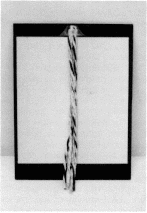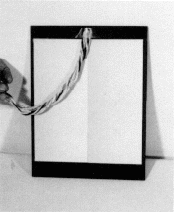
What do you see?
Believe only half of what you see, and nothing of what you hear
Dinah Craik 1858
I start by bringing a group to the exhibit "Gray Step" on the
floor of the museum.
Later I will visit a Snack
version of Gray Step in the classroom.

Observe
I begin by making the "class" active participants in exploration
by asking a question "What do you see?"
This is my favorite starting question for a group of teachers, since
you cannot give a wrong answer.
As guide I can help the observers weave the varied observations into
a nearly complete picture of the phenomena under observation.
Usually people begin by reporting that they see a fiber bundle
covering a gray rectangle.
Others add in a description of the fiber bundle, its length breath
and composition.
Question
After observations begin to taper off I ask if the observations
have generated any questions.
Usually there are few or no questions at this point.
Experiment
If there are questions I seek suggestions for simple experiments that could help answer the questions. Often at this point people suggest moving the fiber bundle to the side. (If no one suggests this, I do.)
Part 2 Then I say, "You look like honest people," and pull the fiber bundle to the side.

There is often a gasp as I ask, "What do you see?"
People respond that they see two rectangles one lighter than the other.
I ask for questions again and this time get many.
A common question might be, "how can the two sides look different when the fiber bundle is in place or removed?"
Followed by the suggested experiment, "put the fiber bundle back."
(There can be many further questions and experiments put forward. see Going Further)
Part 3 Then I say ,"You look like honest people," again. They all look at me quizzically.
I proclaim that both sides, the one that appears light and the one that appears dark, are identical!
The natural reaction at this point is the one that is at the base of all science, "I don't see that!" or even "I don't believe that."
There is a gray piece of plastic with two holes in it that allows us to experimentally compare two regions on the gray step at a time. This viewer allows us to see that both sides of the gray region are equally dark on the left and equally light on the right. (Or using gray step post cards cut the two halves apart and then trim off the edges and exchange them, the dark one becomes light and the light one becomes dark. See Gray Step Postcard)
What's Going On?
A photometer would show that the gray regions change darkness by a few percent from one side to the other, your eye and brain do not perceive this change.
The eye is sensitive to changes in gray level if they are great enough or if they occur over a short distance. After all, you can tell the difference between white and black which are extreme shades of gray.
When one portion of your retina is illuminated by brighter light the sensitivity of the retina in nearby surrounding areas is turned down, this is called lateral inhibition. Conversely if one region is in the dark the sensitivity of surrounding regions is increased. This means that a dark region next to a bright one looks darker and a light region next to a dark one looks brighter than either would look if surrounded by gray. As a result your visual system is most sensitive to changes in brightness imaged over a small region of the retina.
When the pencil is in place the two different grays are spread apart on the retina so that the grays are not in adjacent regions and lateral inhibition does not function. When the pencil is removed the two shades of gray fall on adjacent regions of the retina and lateral inhibition enhances the visibility of the difference between the grays.
The Electric Blanket model of Lateral Inhibition
Consider an electric blanket with two separate controls, one for the right side and one for the left. Place a husband and wife in the bed and give them the two controls, however give the husband the control for the wife's side and the wife the control for the husband's side. As soon as the husband begins to get cold he turns up his control, this makes his wife warm so she turns down her control making the husband colder. This result is like that for lateral inhibition. The husband gets colder and the wife gets warmer.
Going Further
I also ask the observers for suggested experiments.
Examples, I have received are:
Use a fatter or thinner object than the pencil. Try a string, and a thread.
View the gray step from different distances.
Notice in both of the above experiments that it is the angular width of the object covering the edge that matters. A wide object works better at normal viewing distances. However a narrow object works well when viewed closely.
Vary the color of the object.
Notice that some colors work better than others, black pencils work best for me.
Cover only a part of the edge, e.g. the top half.
Use a photometer, a photographers spot meter, it will see the difference from one side of each gray step to the other while the human eye does not.
Work with the cut-up cards, you will discover many neat effects:
Hold cut-ups side by side rotate one.Cut the cards into square regions and rotate one square next to another. Examine all four possible orientations of the square.
Cut a gray step card in half along the center line. Cut one side into a disk, place it over the other, uncut, side. Rotate the gray step disk in front of the gray step card.
Cut out the two regions of the gray step card. Place them over a white piece of typing paper. Rotate the two gray steps so that the white edges are together in the middle, then rotate them so the dark edges are together in the middle. Note how the darkness of the cards changes against the background.
Etc
In telescope views of Mars Percival Lowel saw Canals, straight dark lines on the planet. Other observers saw a green wave spread from the north pole each northern hemisphere Martian spring. Some people interpreted these as signs of intelligent life on Mars. They were signs of intelligent life all right, the human eye-brain system. Humans will sometimes see a row of blotches as a straight line. The green wave was actually gray, but it appeared green next to the background red color of Mars.
Further reading
The scientific American Library book Eye, Brain, Vision
Seeing the Light, by David Falk, Deiter Brill, and David Stork
Eye and Brain, by Richard Gregory
Snack, a small inexpensive version of an exhibit, usually costing under $10. Snacks can be built by students and then used by them to investigate scientific phenomena. Return.
Scientific
Explorations with Paul
Doherty 18 September 2002